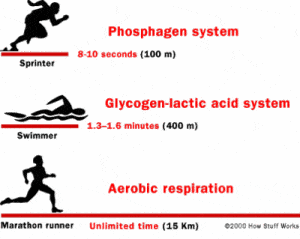
1. Explosive Force – The ATP-CP System
ADP + Creatine phosphate (CP) ==> ATP + Creatine
Fast, doesn’t require oxygen, but extremely limited to short periods of explosive force i.e. all out sprints
2. Sugar Burning – Step 1 (Anaerobic Glycolysis)
ADP + glucose ==> ATP + pyruvic acid (which converts to lactate if not burned with oxygen)
As lactic acid builds up in your muscles, you start to feel them “burn”. If you go beyond a few minutes of this, the acidity of the muscle tissue increases and the muscles start to have difficulty generating meaningful amounts of energy. (1-3 minute) wind sprints and mid-range resistance training (8-12 repetitions) into your program. Since that work is also the basis of much of your muscle gain, you support it nutritionally with post-exercise protein, especially sources including the amino acid leucine, such as whey protein, and supplements including glutamine, vitamin C, and plenty of water.
3. Sugar Burning – Step 2 (Aerobic Glycolysis)
This is the next system, and for all practical purposes is the one you use most often when exercising. Once glucose has been converted to lactate anaerobically (without oxygen), the body then burns the lactate using oxygen to create even more ATP.
ADP + lactate + oxygen ==> ATP + water + carbon dioxide
You train this system by including sustained aerobic activity (20-40 minutes depending on intensity) into your program. You support it nutritionally by taking in some form of carbohydrate within 45-60 minutes after your workout. If you’re targeting muscle gain more than fat loss, that post-workout meal is the only one that should generally include “high glycemic” carbs like bread, bagels, sugars, etc., since those carbohydrates will be used preferentially by the muscles at that time to rebuild glycogen.
4. Fat Burning (Aerobic Lipolysis)
This is by far the slowest system. It is, in fact, too slow to contribute extensively to energy production during exercise (if you ever deplete your glycogen stores so much that the body has to rely on fat burning for its energy, your muscle movement slows down dramatically). In order to mobilize fat, a “triglyceride” has to be broken down into fatty acids, bound to proteins, and other time-consuming feats. The good news is that fat metabolism is the main way that your glycogen stores are replenished after exercise.
Fat + oxygen + ADP ==> ATP + water + carbon dioxide
Though some trainers suggest long, slow aerobic workouts to burn fat, that’s a very inefficient approach and can also compromise muscle gains. You train the lypolytic system best by working glycogen-depleting exercises like resistance training and wind sprints into your program (which give you an “afterburn” as you rebuild ATP through fat burning), working out in the morning on an empty stomach (in any case, definitely avoid sugary or high-glycemic carbs before workouts – insulin blocks fat burning), waiting about 30-60 minutes after the workout before having much carbohydrate, and by maintaining a nutrition plan of small meals that aren’t large enough or glycemic enough to spike your blood sugar. You can also have a cup of caffeinated coffee (no cream or sugar) before workouts if it doesn’t irritate your stomach – the caffeine triggers release of fatty acids into the bloodstream and will improve your endurance.
Original article from: http://www.hussmanfitness.org/html/TLEnergySystems.html

You must be logged in to post a comment.